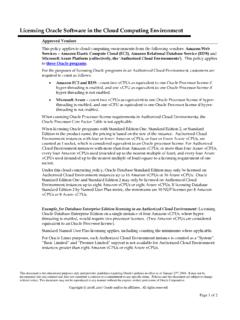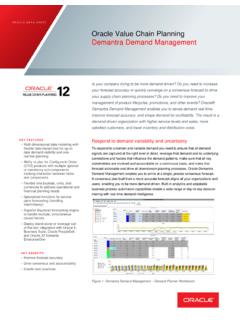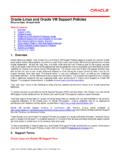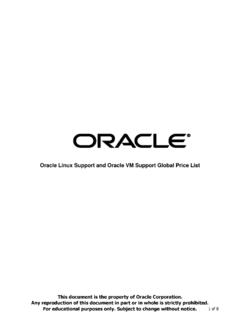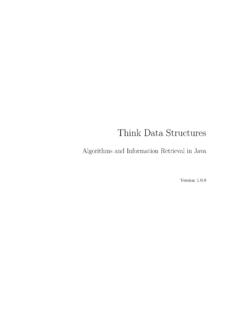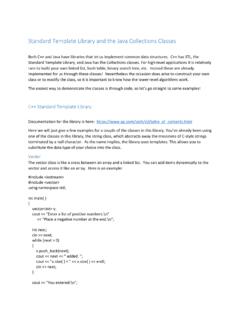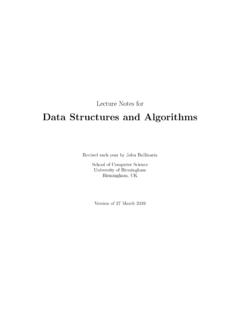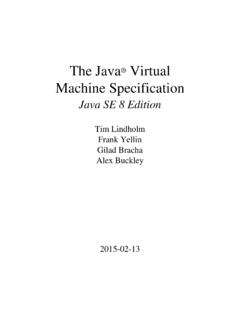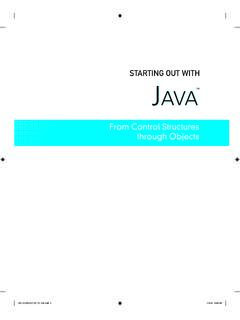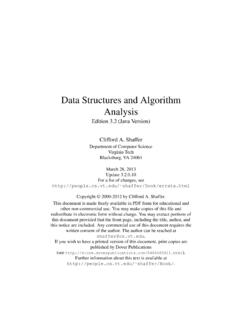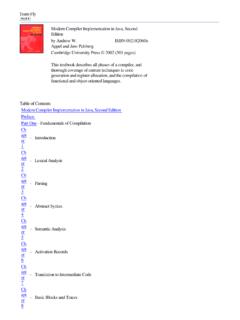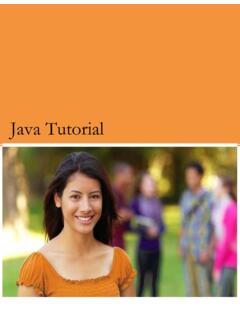Transcription of Java Code Conventions - Oracle
1 JavaCode ConventionsSeptember 12, 1997iiPleaseRecycleCopyright Information 1997, Sun Microsystems, Inc. All rights Garcia Avenue, Mountain View, California 94043-1100 document is protected by copyright. No part of this document may be reproduced in any form by any meanswithout prior written authorization of Sun and its licensors, if information described in this document may be protected by one or more patents, foreign patents, orpending , Sun Microsystems, Sun Microelectronics, the Sun Logo, SunXTL, JavaSoft, JavaOS, the JavaSoft Logo, java ,HotJava Views, HotJJavaChips, picoJava, microJava, UltraJava, JDBC, the java Cup and Steam Logo, Write Once,Run Anywhere and Solaris are trademarks or registered trademarks of Sun Microsystems, Inc.
2 In the United Statesand other is a registered trademark in the United States and other countries, exclusively licensed through X/OpenCompany, is a registered trademark of Adobe Systems, Navigator is a trademark of Netscape Communications other product names mentioned herein are the trademarks of their respective DOCUMENT IS PROVIDED AS IS WITHOUT WARRANTY OF ANY KIND, EITHER EXPRESS ORIMPLIED, INCLUDING, BUT NOT LIMITED TO, THE IMPLIED WARRANTIES OF MERCHANTABILITY,FITNESS FOR A PARTICULAR PURPOSE, OR DOCUMENT COULD INCLUDE TECHNICAL INACCURACIES OR TYPOGRAPHICAL ARE PERIODICALLY ADDED TO THE INFORMATION HEREIN; THESE CHANGES WILL BEINCORPORATED IN NEW EDITIONS OF THE DOCUMENT. SUN MICROSYSTEMS, INC.
3 MAY MAKEIMPROVEMENTS AND/OR CHANGES IN THE PRODUCT(S) AND/OR THE PROGRAM(S) DESCRIBED IN THISDOCUMENT AT ANY 2, 1997iii1 Introduction.. Have Code Conventions .. 12 File Names .. Suffixes .. File Names .. 23 File Organization .. Source Files .. Comments.. and Import Statements .. and Interface Declarations .. 34 Indentation .. Length .. Lines .. 45 Comments .. Comment Formats .. Comments .. Comments .. Comments.. Comments.. Comments .. 86 Declarations .. Per Line .. and Interface Declarations .. 107 Statements .. Statements .. Statements .. Statements .. , if-else, if-else-if-else Statements .. Statements.
4 Statements.. Statements .. Statements .. Statements .. 138 White Space .. Lines.. Spaces .. 149 Naming Conventions .. 1410 Programming Practices .. Access to Instance and Class Variables .. 15 June 2, to Class Variables and Methods .. Assignments .. Practices .. Values .. before ? in the Conditional Operator.. Comments .. 1711 Code Examples .. Source File Example.. 182 - File Names1 java Code Conventions1 -Introduction Have Code ConventionsCode Conventions are important to programmers for a number of reasons: 80% of the lifetime cost of a piece of software goes to maintenance. Hardly any software is maintained for its whole life by the original author.
5 Code Conventions improve the readability of the software, allowing engineers tounderstand new code more quickly and thoroughly. If you ship your source code as a product, you need to make sure it is as well packagedand clean as any other product you create. document reflects the java language coding standards presented in theJava LanguageSpecification, from Sun Microsystems. Major contributions are from Peter King, PatrickNaughton, Mike DeMoney, Jonni Kanerva, Kathy Walrath, and Scott questions concerning adaptation, modification, or redistribution of this document, pleaseread our copyright notice at on this document should be submitted to our feedback form at -File NamesThis section lists commonly used file suffixes and - File Names23 - File Organization3 SuffixesJavaSoft uses the following file suffixes: File NamesFrequently used file names include.
6 3 -File OrganizationA file consists of sections that should be separated by blank lines and an optional commentidentifying each longer than 2000 lines are cumbersome and should be an example of a java program properly formatted, see java Source File Example on page19. Source FilesEach java source file contains a single public class or interface. When private classes andinterfaces are associated with a public class, you can put them in the same source file as thepublic class. The public class should be the first class or interface in the source files have the following ordering: Beginning comments (see Beginning Comments on page 4) Package and Import statements; for example:import ;import *;import *; Class and interface declarations (see Class and Interface Declarations on page 4)File TypeSuffixJava NameUseGNUmakefileThe preferred name for usegnumake to build our preferred name for the file that summarizes thecontents of a particular - File CommentsAll source files should begin with a c-style comment that lists the programmer(s), the date, acopyright notice, and also a brief description of the purpose of the program.
7 For example:/* *Classname* * Version info * *Copyright notice * and Import StatementsThe first non-comment line of most java source files is apackage statement. After that,import statements can follow. For example:package ;import ; and Interface DeclarationsThe following table describes the parts of a class or interface declaration, in the order that theyshould appear. See java Source File Example on page 19 for an example that of Class/InterfaceDeclarationNotes1 Class/interface documentationcomment (/**..*/)See Documentation Comments on page 9 forinformation on what should be in this orinterface statement3 Class/interface implementationcomment (/*..*/), if necessaryThis comment should contain any class-wide orinterface-wide information that wasn t appropri-ate for the class/interface documentation (static) variablesFirst thepublic class variables, then thepro-tected, and then variablesFirstpublic, thenprotected, and - Indentation54 -IndentationFour spaces should be used as the unit of indentation.
8 The exact construction of the indentation(spaces vs. tabs) is unspecified. Tabs must be set exactly every 8 spaces (not 4). LengthAvoid lines longer than 80 characters, since they re not handled well by many terminals :Examples for use in documentation should have a shorter line length generally nomore than 70 characters. LinesWhen an expression will not fit on a single line, break it according to these general principles: Break after a comma. Break before an operator. Prefer higher-level breaks to lower-level breaks. Align the new line with the beginning of the expression at the same level on the previousline. If the above rules lead to confusing code or to code that s squished up against the rightmargin, just indent 8 spaces are some examples of breaking method calls:function(longExpression1, longExpression2, longExpression3, longExpression4, longExpression5);var = function1(longExpression1, function2(longExpression2, longExpression3));7 MethodsThese methods should be grouped by functional-ity rather than by scope or accessibility.
9 Forexample, a private class method can be inbetween two public instance methods. The goal isto make reading and understanding the code of Class/InterfaceDeclarationNotes4 - Indentation6 Following are two examples of breaking an arithmetic expression. The first is preferred, sincethe break occurs outside the parenthesized expression, which is at a higher = longName2 * (longName3 + longName4 - longName5) + 4 * longname6; // PREFER longName1 = longName2 * (longName3 + longName4 - longName5) + 4 * longname6; // AVOIDF ollowing are two examples of indenting method declarations. The first is the conventionalcase. The second would shift the second and third lines to the far right if it used conventionalindentation, so instead it indents only 8 INDENTATION someMethod(int anArg, Object anotherArg, String yetAnotherArg, Object andStillAnother) {.}
10 }//INDENT 8 SPACES TO AVOID VERY DEEP INDENTS private static synchronized horkingLongMethodName(int anArg, Object anotherArg, String yetAnotherArg, Object andStillAnother) { ..}Line wrapping forif statements should generally use the 8-space rule, since conventional (4space) indentation makes seeing the body difficult. For example://DON T USE THIS INDENTATIONif ((condition1 && condition2) || (condition3 && condition4) ||!(condition5 && condition6)) { //BAD WRAPS doSomethingAboutIt(); //MAKE THIS LINE EASY TO MISS}//USE THIS INDENTATION INSTEADif ((condition1 && condition2) || (condition3 && condition4) ||!(condition5 && condition6)) { doSomethingAboutIt();}//OR USE THISif ((condition1 && condition2) || (condition3 && condition4) ||!)
